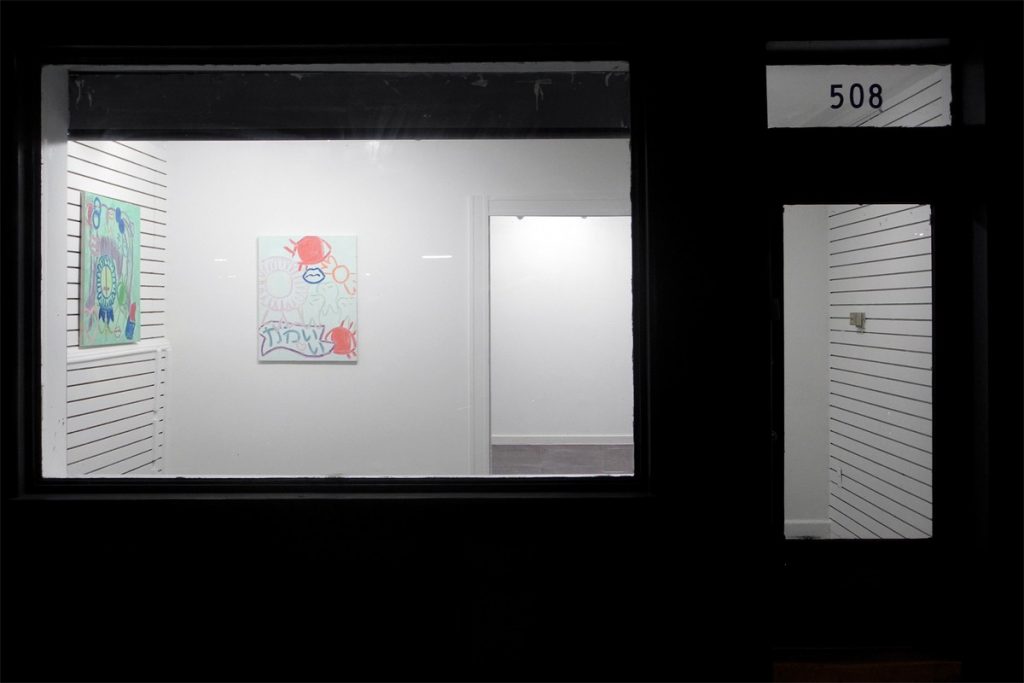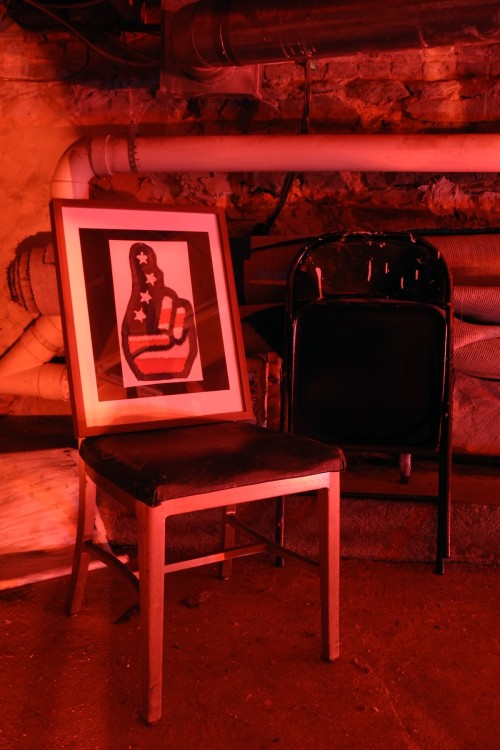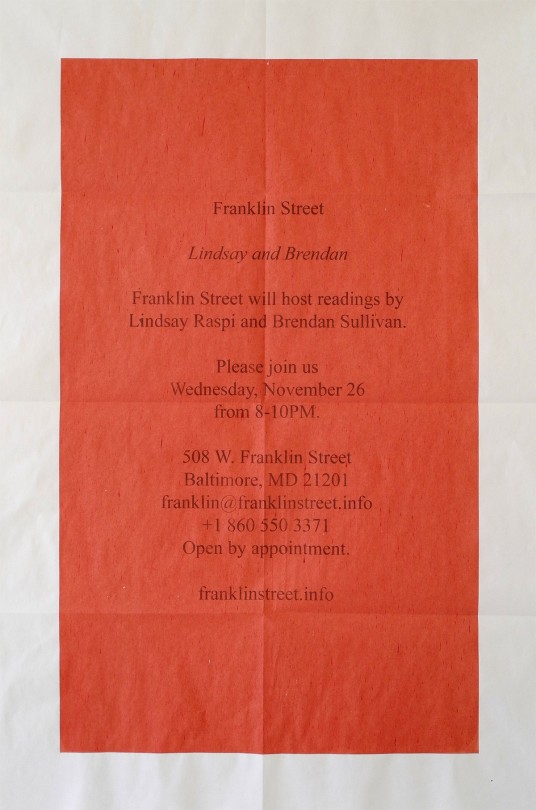Franklin Street is an arts space located on West Franklin Street in the Seton Hill neighborhood of Baltimore, MD. Curator/artist Jordan Bernier sat down to talk about the project recently.
-Editor
~~~
CA: When did you start Franklin Street?
JB: I got into the space on May 1st.
Was that directly following sophiajacob or did that have some overlap?
Yeah, it must have been just a few days later. I signed the lease when sophiajacob was still going on. So there’s overlap in that way, but no, the spaces were separate.
When you started, had you been thinking that you wanted to do something solo? Or just that it happened to work together with that timing?
Yeah, it was like, keeping projects going, but trying to put stuff together myself was the direction I wanted to attempt.
Do you know how many shows you’ve done at this point since May?
Well the space opened in June–
Oh, ok, first show.
–Right, fixing the space for a little bit. I don’t know. Twelve? Fifteen? Including performances and, you know. [Actually 22 shows in 7-8 months -Ed. note]
Yeah.

[AMELIA, BUDDY, ELENA, AND STEVE]
Some months it’s two things, and some months it’s three things. Have you been to a bunch of them?
I haven’t been to even half. Or, maybe I’ve been to half. I’ve seen a good number, but not every one.
Right.
Do you have a strong intention that you’re working with when you’re going through each show, curating, finding artists, or do things just happen and then you work with them?
There’s a little bit of both. I mean, you try to work with your friends, you know? And work a little bit outside that realm, but mostly, it’s my friends. So in that way I kind of know what I’m getting personality wise, but I don’t know what I’m getting content wise, maybe. Things will show up and i’m like, “OK, where do we put that one?” But yeah, so I guess it’s a little bit of both.
Do you strictly draw from a pool of Baltimore artists? That seems to go hand in hand with working with your friends, I guess, but, has that stayed consistent in the project?
It isn’t a strict rule, but you’re right, most artists in the program are currently living in Baltimore. The most recent show with Nick Mayer is an exception, he’s from New York at the moment. He used to live in Baltimore though!
I think that going to those shows you can get the sense– I guess its funny because the crowd is always very similar and so it feels like there’s a community that revolves around it, but they’re always casual enough that it almost feels like a studio visit made formal–
Oh, OK, yeah.
–that is just a platform with which to have a community meeting around.

[NOEL FREIBERT]
Yeah, so maybe you’ve picked up that it’s a little bit less rigid than our sophiajacob project right where it was like, “This is the opening, Saturday night, this time,” or whatever, and that’s awesome, but this was kind of like, “Loosen up a little bit.” Yeah, I’m glad you picked up on the– hopefully its not too cliquey or anything– but I do want it to be a positive space for people. Not too stand off-ish or something.
Yeah, I think it always has a sense of openness (rather than exclusiveness), but I guess something that goes along with that is– well I guess, first, do you promote any of those shows online?
There’s a mailing list and a website, so if you’re signed up to the mailing list (and anybody can sign up) then you get the emails, and if you check the website, I try to update every week, but I don’t do any social media.
Yeah. So, that’s like “the thing.”
It was actually the one thing that when you asked me about this interview that I was like– because Post-Office is like a Tumblr format, right?
Yeah.
And I was like, it’s a social media thing.
Oh, true.
But you’re my friend and I thought it would be a fun conversation.
Do you use social media in your personal life or does that come from a specific view towards social media in the arts? Or is it just not something you’re interested in?
Not in my personal life.
* * * *

[NICHOLAS LYNCH]
The way I was leading into that, I was thinking that those shows are probably some of the most well promoted shows, physically, in a way. I mean you always have the screen printing set up very– like, there’s never a show that goes non-promoted physically, and it’s probably the most substantial flyering around baltimore [at this point].
Oh, cool. Yeah, I’m trying to do that. I mean, “posters” has been my thing for a while, you know with the sophiajacob lectures. It took a couple shows to figure out that format, and once I figured it out, I was like “Okay.” I mean it’s a fun way to keep my hand in the art work.
And it is nice to have something so consistent, I mean I was trying to figure out– “Jordan must spend a lot of time–”
[Both laughing]
–-Not that they’re super involved; Obviously, it’s a simple and meditative task.
Yeah, like the color stencil, that’s always there. And it’s just mixing, finding the right color to go with the show.
That’s nice. I guess going from that, it is funny to me that the crowd does feel consistent, or that something does feel communal, that the same people keep coming back even though it does have a strong promotional thing.
Sure, sure.
It’s like, on paper, “Well, he hit this many intersections…” and then its still the same people coming out. Maybe it’s the graphic design or something, maybe there’s a [visual] language in the public sphere that has a certain graphic design that lends itself to certain audiences.
It could be. I mean I try to make it open–I put my phone number on them, there’s the website, the email– I do try to make it as open as possible, but you’re right, we still have this consistent base that shows up at every show. I would like to, of course, if anybody’s curious, it would be cool to have them come out. Or send an email for an appointment.
What I’m saying is, I hope the design isn’t too stand-offish or something.
Yeah. I mean it’s hard to know, I feel like I go to the shows and that I’m welcome, so I don’t know if someone who was not an artist or something would just be like, “Times New Roman?” “There’s no flash?” or, you know? You look like at “On Purpose: Women” [pointing to a magazine stand across the room] and it has to go through a certain number of hoops to fit into that demographic of graphic design. I dunno, we don’t need to harp on this for too long, it’s just something I’m curious about: how these languages get set up and how you might determine–and this is going separate at this point, but–how stores can kind of choose their demographic by choosing graphic design. So, you can tell when a store is going to be a “Hipster Cafe” or something, because they do the circular, very clean, nostalgic looking font vs. 99¢ SALE ALL ITEMS READY TO GO etc. etc.
Yeah.
[Jordan later explained that his particular design is actually lifted from a Netherlandish Beach Boys album release]
***

Working as a curator who has played the curatorial role pretty extensively at this point–
–For a couple years.
–For a few years, you know, but, pretty actively.
That’s good to– yeah, haha, hopefully.
I don’t know if you designate a specific painting practice or if you hold an all encompassing practice (or if you feel like there’s any overlap), but – the basic question being, do you feel like [your painting and curatorial practices are] separate, and if they affect each other in a certain way?
They definitely affect each other, especially time-wise. There are definitely times when you don’t have any time to get into the studio. So, there’s that effect, of course. But I do try to incorporate them. Maybe the collaborative paintings might be the best analogy in a visual art or a painting way, because the collaborations between Caitlin or Steve or John Bohl–that’s how I see putting together the shows at Franklin Street, you just collaborate with somebody. Whether it is the poster or the actual design of the show. As much designed as they can be. Hopefully they work together, I mean, there’s times when I don’t see them fit as well as they could, but I don’t know. So maybe it’s for other people to decide, I don’t know. But, I do try to maintain a consistent studio thing going on.
* * * *
How do you feel like Baltimore as a community, or a space, lends to your practice, if that’s a driving force?
It’s hard, because I don’t know what it’s like to work in other cities that much. I know Portland because I lived there for a little bit, but then I moved back here because of the availability of space. And yeah I do like the community. It is good.
It is good.
I mean nothing’s perfect. Haha. But like the landscape for artists in the past 10 years has – it’s so much better.
Mmhmm
Definitely. When I think about the projects that were going on when I was in undergrad, that was like– it was cool, there was excitement. But now it’s opened up for people a lot, and I think it’s just way better now.
Yeah, I’ve been thinking about Baltimore a lot recently, trying to figure out which thoughts are valid, which ones are naïve because i’m young and trying to be idealistic, and which ones are because I just don’t have enough information since I’ve only been here for five years. But one of the things, to hear you say that it’s way better now than it was, is super interesting because I’m frequently thinking similar things.
* * * *

[STEVEN BOOTH]
As far as working here– I mean its the same thing as everyone says. You have a warehouse with space, you know, it’s not that expensive. But really it’s like: my friends live here. That’s the way it is.
Build a community, then you know it.
I think every city has its spot, not because there are warehouses but because that’s where your friends live. I would like to think that that is the reason why.
I grew up outside of Cleveland, OH, and I was there until I was 15–my family moved to New Jersey after so I was there during high school–and then came here, but I was immediately drawing connections between Cleveland and Baltimore just because what the ports [and mills] were for Baltimore, steel was for Cleveland. And being in such a similar position, growing up and reading news articles talking about the decreasing city populations, and now beginning to hear Cleveland listed along with Baltimore and Detroit and other rising –
“Up and coming,” you know–
–Yeah, cities. And they’re so quick to make those claims in the papers… Prospecting, I guess?
Sure, sure.
In a direct kind of code language for developers that is like, “Now’s the time to start thinking about real estate!”
And that’s why I say there’s good and bad. I feel like at the H&H, every couple months you hear word about development plans and it’s definitely– I don’t know if scary is the right word, but it’s definitely uncomfortable to hear that stuff. And anytime things change, it makes you feel a little uncomfortable. And that’s just the way it is.
* * * *
Oh yeah, I have to get this–
Franklin street is not really a gallery in some ways as much as like– the way things move along, I don’t want people, at least the people that go to the shows, to have that idea that, “This is a gallery, and this is the way the lighting is and it’s up for this long and it’s on this cycle that’s predetermined.” Or something. Hopefully the project (and it will end at the end of April) will help break that down a little bit. I don’t know, maybe it doesn’t make any difference. Maybe people see them as like really straightforward shows.
I can’t always tell.
Hahaha.
That’s nice.